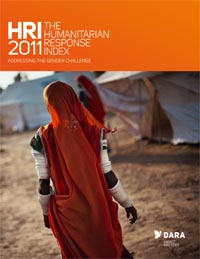February 27, 2012
A word from Ross Mountain: February 2012
This year marks the end of the first five-year phase of the Humanitarian Response Index (HRI). Since the initiative began, we have learned a great deal about the challenge of effectively providing humanitarian assistance in an increasingly complicated operating environment and the strengths and limitations of the different actors involved in the humanitarian sector. We have found that huge difficulties exist in translating our collective commitment to increase the impact and effectiveness of aid efforts into actual changes in policy and practice.
The context in which humanitarian action takes place has evolved substantially over the past five years of the HRI — the Arab Spring is evidence of just how quickly the dynamics can shift. At the same time, too many crises, like the Horn of Africa, remain sadly familiar to us despite our pledges to avoid mistakes of the past. This reinforces the need to constantly track trends and assess the implications for the sector.
Through the HRI’s extensive research over the past five years, we have been able to gather evidence on how the humanitarian sector is functioning, and from this, raise concerns about important issues that affect the quality and effectiveness of humanitarian action. This ranges from the importance of need-based approaches and the dangers of aid politicisation, to the need for better prevention, preparedness, and risk reduction, and support for protection and access. All these issues are by no means new for the sector, but as our research shows, much more effort is required to address them in a lasting and meaningful manner.
In this year’s report, we turn our attention to the challenge of incorporating gender more effectively into programming, and the role that donors can play to push the system to improve in this area.
From our perspective, the issue of gender in crises is simple: we will never be able to achieve principled and effective responses unless we can show that assistance is based on, and in proportion to the needs and priorities of all parts of the affected populations, and provided impartially. The only way to achieve this is by ensuring needs assessments and programme design adequately integrate gender analysis, and by constantly monitoring and evaluating the results of our actions to ensure gender concerns are addressed properly.
This year’s report includes expanded analysis of individual donors’ policies and practices, based on key elements of the declaration of Good Humanitarian Donorship (GHD). Our analysis is based on hundreds of interviews and published data. We have found that each donor contributes, but all could do more to realise the ambitious aims of the GHD.
It is critically important to consider the HRI’s findings and analysis, not as absolute truths, but as evidence of trends in donors’ practices that can help policy-makers and their partners reflect on what is working well and what can be improved.
While the HRI has primarily focused on the role of donor governments in humanitarian action, our scope and ambition has always been to look beyond this to see how we can collectively do better for those suffering from crises.
As we look forward to the next phase of the HRI, it is clear that both the new operational contexts and developments in reforming the structure and tools of the humanitarian sector, call for a period of reflection to redefine good practice. The challenges posed by climate change, rapid population growth and tighter financial budgets will require the humanitarian sector to be prepared for even greater
challenges. The growing importance of new operational actors and donors is a reality that “traditional” actors need to acknowledge and embrace as part of the growing aid community.
I sincerely hope you will join us in widening the debate to include new actors and contexts, consider the future challenges facing the sector, and look for practical solutions on how we can maximise the resources and support of donors and humanitarian organisations to meet the needs of people affected by, or at risk of crises.

Share this